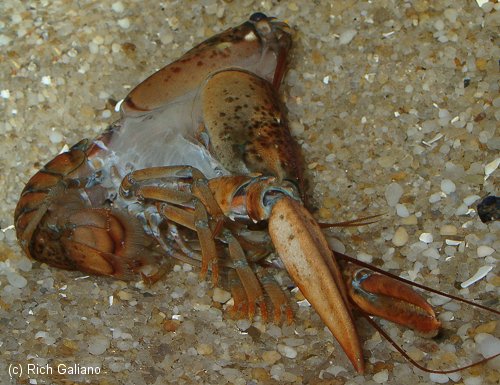American Lobster (5/6)
Lobster Molting

The shell has just split between the tail and the body. The old shell is lifting off, revealing the new one beneath. By now the animal has withdrawn much of the calcium from the old shell and stored it in its blood and tissues. This weakens the old shell in preparation for molting while allowing the lobster to reclaim precious materials for its new shell.

Although it's not readily apparent, the legs and claws are now pulling out of their casings in the old shell. The tail is still firmly inside and is the last part to be withdrawn.
The lobster is completely defenseless at this point and doesn't seem to be making much progress.

Finally, the eyes appear, and the head emerges. The antennae are folded down and still tucked inside their old casings. The legs and claws are all still trapped and hidden from view beneath the old shell. The tail is beginning to break free.
Things are moving much faster now. The entire sequence here covered about 15 minutes.

Most of the tail is now free, as are the legs. The claws begin to emerge, still trapped under the old shell. The antennae are also almost free, folded down between the legs.
In our waters, lobsters typically molt twice a year; in colder waters north of here, just once.
This is the most hazardous time in a lobster's life, and it would not normally molt out in the open where it could be attacked. I watched over this one after exposing it until it could make its own way again.

A flick of the tail now, and the lobster will be free of its old shell. The new shell is soft, leathery, and flexible.
For several minutes the lobster is completely helpless - its legs are so soft and rubbery that it cannot even stand up. The claws are creased and folded.

Initially, the "new" lobster is not noticeably bigger than the "old" one. In the next 15-20 minutes the animal will absorb enough water to inflate the new shell until it is about 30% bigger than the old one, and then re-deposit the stored calcium to harden it. This stiffens the shell and legs to where they are functional again, so that the lobster can walk, swim, and dig, although it will still be soft and vulnerable for several days.
All pictures taken off the coast of New Jersey


